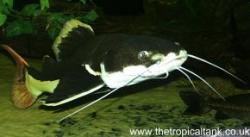|
|
The Big Fish Campaign
|
This article was originally published in the Fish Forum of the March 2012 issue of the
Newcastle North Advertiser. |
| |
|
Just like any other pet or companion animal, the needs of aquarium fish must be considered before they are purchased. There are a number of factors to consider, but one of the most important of these is clearly the adult size of the fish, and the size of aquarium it will therefore require.
Unfortunately, many fish are sold without adequate information being provided about the adult size they can be expected to obtain. Additionally, many potential fishkeepers fail to do adequate research themselves prior to purchase, to make sure they are buying fish that are suitable for the home they can provide.
This has resulted in many fish outgrowing their homes, and fishkeepers then find that they have difficulty in finding suitable new homes for them. Aquatic shops will often be reluctant to take in large fish that they themselves will find difficult to re-home. Unable to find any other home for these fish, some fishkeepers have contacted public aquaria, assuming that the huge display tanks in such facilities will be able to house their unwanted "tankbuster" fish.
|
|
The Big Fish Campaign is an initiative that began in late 2005, stemming from the problems that public aquaria were having as a result of being offered unwanted fish that had outgrown their homes. Recently, the Aquarium Working Group of BIAZA (British and Irish Association of Zoos and Aquariums) has revived the campaign to bring more focus to an ongoing problem.
|
 |
|
The numbers and types of fish being offered have very quickly outstripped what the public aquaria are able to accommodate. Many of the large display tanks at public aquaria are often saltwater tanks, and therefore unsuitable for the mainly freshwater fish being offered. In addition, many displays will be specialised or themed displays to highlight specific habitats in the wild, and unsuitable for many of the large fish being offered.
|
|
Many public aquarium facilities will also be keen to devote their available space to education, conservation and research efforts, rather than simply housing a mix of unwanted large fish; many of which are commonly available in the aquatic trade, not endangered in the wild, or may even be mass-produced as food fish, and hence are of little value for education or research.
|
|
It was clear from a recent meeting of those supporting the Big Fish Campaign, that both public aquaria and aquatic shops are still being offered large numbers of these fish. In many cases, those trying to re-home the fish claimed that they were not told about the potential size of the fish when purchasing. Worse still, when told that the facility in question simply could not house the fish, some members of the public have become abusive, or tried to blackmail the shop or aquarium into taking the fish by threatening to kill it, or release it into the wild (which is a criminal offence).
This highlights the desperate situation in which many fishkeepers find themselves, and emphasises the need for something to be done to reduce the numbers of unsuitable fish being sold for home aquaria.
|
| |
|
The focus of the campaign has been largely on freshwater tropical fish, as this represents the biggest part of the problem, though there are some marine species of concern, as well as coldwater and pond fish.
Exactly what constitutes a "big fish" is open to debate, and those involved with the fishkeeping hobby are likely to have different opinions depending on their own preferences and experiences.
To most fishkeepers maintaining an average tropical community tank, anything that grows to 15cm (6”) or more is likely to be considered a large fish. For serious hobbyists that like to keep the large specimen fish, sizes of 30-60cm (12-24”) are likely to be the norm.
There is a place in the hobby for many of these larger fish, as long as they are sold in a responsible manner to fishkeepers who understand the commitment and expense involved in housing these fish properly.
|
| However, there are some species, notably Pacu and all species of Pangasius catfish, that really do not belong in the aquatic trade. There are simply not enough fishkeepers out there with tanks anywhere near large enough to house such fish humanely.
|
 |
|
Adult Pacu are huge deep-bodied fish and Pangasius catfish not only grow huge, they have a tendency to damage themselves by hitting the aquarium sides when they frequently bolt across the tank when startled – in short they are highly unsuitable as aquarium fish.
Another problem with these fish is that Pacu and Pangasius are often available cheaply as small juvenile fish, so may be bought by unsuspecting new fishkeepers – and sadly some retailers seem happy to take money from unsuspecting buyers without warning them about the potential size of the fish they are purchasing. The catfish species known scientifically as Pangasius or Pangasionodon are sold with a number of common names, including iridescent shark, paroon shark, shark catfish, etc – so check carefully before buying any silvery-coloured shark-like catfish! Another shark-like catfish usually known as the Colombian Shark Catfish is also unsuitable for most home aquaria.
|
|
Another traditional ‘problem fish’ when it comes to adult size is the Red-Tailed Catfish. There’s no doubt that these are magnificent-looking catfish and it’s obvious why many fishkeepers would be attracted to them, but sadly their adult size means that very, very few fishkeepers can accommodate them as adults.
|  |
|
Most commercially available aquarium tanks are less than 150cm (about 5ft) in length, so anything larger often has to be custom made. Many fishkeepers would consider a tank that measures 180 x 60 x 60cm (6 x 2 x 2 ft) and holds around 680 litres (150 gallons) to be a large tank, but a young red-tailed catfish will outgrow a tank of those dimensions within a couple of years. When you consider that large catfish can easily live a couple of decades, it’s obvious that housing them for their natural lifespan is a huge commitment.
|
|
Recent times have also seen the emergence of hybrid catfish where red-tailed catfish have been crossed with other large catfish to produce a number of different hybrids. The problem caused by these hybrids adds another element: they were not so widely recognisable as the pure red-tailed catfish, and initially there was little information available as to how large they would grow. With a new hybrid, there is a possibility that the fish might reach the same adult size as one or other of its parents, or it might grow larger than both species – so-called "hybrid vigour" can sometimes produce larger animals than the parent species, which in this context is not a good thing.
It might seem that some sort of licensing could be the answer. However, implementing a licensing system would require a huge amount of resource, especially if it were to be policed effectively, so in reality it’s unlikely to be a practical solution.
A major problem with licensing or any other form of control, is defining exactly what species should belong on any restricted list. Although there are some obvious candidates, such as the aforementioned Pacu and Pangasius, there are dozens more large species that are only imported very rarely, and which may be less easy to identify or control, due to them being imported only occasionally.
However, one positive aspect of these rarer species is that they are much less likely to become a significant problem. The numbers imported are small, they are often stocked only by more specialist shops, and their rarity usually makes them quite expensive and hence less likely to be bought on impulse, particularly by newcomers to the hobby searching for suitable community fish.
|
|
It might seem like an obvious solution to simply restrict the sale of certain species based on size alone. However, the adult length of a fish is not in itself the only determining factor as to its suitability for a particular tank size. Consider two fish species, both 12” (30cm) in length, where one is an active mid-water shoaling species that swims almost constantly and the other a bottom-dwelling species that remains largely inactive except when seeking food. Clearly the first example requires much more tank space to thrive than the second example. As a further example, a 24” (60cm) Moray Eel is a sinuous snake-like fish and clearly very different in its space requirements to a deep-bodied heavily-built fish like a 24” Pacu.
There are also issues when it comes to defining the actual size of a fish when considering if it should belong on any restricted list. These include the definitive source used for size information, and the question of whether the size used for reference should be the maximum possible size known, or the average size of wild specimens, or a typical size in captivity (if known). To err on the side of caution, it might seem sensible to go with the maximum quoted size. However, the largest example of a species ever measured will not be a useful reflection of the size that most specimens will achieve. This point can be easily demonstrated when you consider that the world’s tallest known human was confirmed at almost 9 feet tall - but the majority of humans reach less than two-thirds of that size – and hence we don’t generally design buildings or cars to cater for people 9 feet tall!
It would be very unfortunate if a blanket ban were ever introduced on aquarium fish over a certain size. It would probably also be quite damaging to the aquatic trade, and therefore to the hobby itself.
The Big Fish Campaign is not seeking to have certain species banned or licensed. It is hoped that a campaign with the emphasis on responsible selling, self-regulation and raising awareness will lead to a noticeable reduction in the problem of fish outgrowing their homes, and hence negate the need for more drastic measures involving fish been banned from sale or restricted by unworkable or ineffective licensing systems.
|
| |
|
The campaign will be focusing on more positive measures, to include:
Raising general awareness about the scale of the big fish problem.
Encouraging fishkeepers to research fish before they buy, and ignore myths that “fish only grow in relation to the size of the tank”.
Encouraging retailers and wholesalers not to routinely stock the most problematic species such as Pacu, Pangasius, and the Red-Tailed Catfish and its hybrids.
Asking retailers to make sure that all other potentially large fish are correctly labelled with a realistic adult size, and to ensure that they are sold responsibly to those that can provide a suitable long-term home.
|
|
Support for this campaign has already been voiced on the website of Practical Fishkeeping magazine and in the trade publication PBW News/Aquatic Trader. It is hoped that everyone from fishkeepers themselves to wholesalers, specialist aquatic retailers, pet shops, garden centres and the larger chain stores will support the campaign and limit the sale of the ‘worst offenders’, and take a responsible attitude towards buying and selling other larger fish.
A Facebook page has been set up, and more information can also be found on the BIAZA website.
|
This article Copyright © 2012 Sean Evans. All rights reserved.
[Home]
[Article Library]
[Fish Index]
[Tank Setups]
[Forum]
[Site Map]
|
|
|





